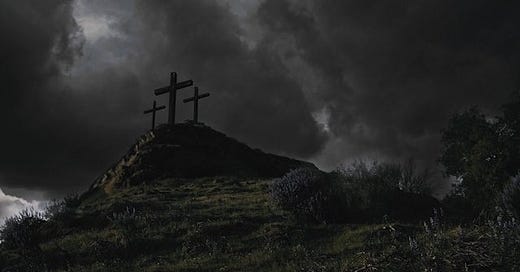“Easter is calculated as the Sunday that follows the first moon after the vernal equinox. It is evidence of a concern centuries before Christ to coordinate the lunar and solar calendars. What we have to recognize is that these celestial bodies represented to the ancients two different modes of eternal life, one engaged in the field of time, like throwing off death, as the moon its shadow, to be born again; the other, disengaged and eternal. The dating of Easter according to both lunar and solar calendars suggests that life, like the light that is reborn in the moon and eternal in the sun, finally is one.”
—Joseph Campbell
What has always been basic to Easter, or resurrection, is crucifixion. If you want resurrection, you must have crucifixion. Too many interpretations of the Crucifixion have failed to emphasize that relationship and emphasize instead the calamity of the event.
If you emphasize the calamity, you look for someone to blame, which is why people have blamed the Jews. But crucifixion is not a calamity if it leads to new life. Through Christ’s crucifixion we were unshelled, which enabled us to be born to resurrection. That is not a calamity. So, we must take a fresh look at this event if its symbolism is to be sensed.
If we think of the Crucifixion only in historical terms, we lose the symbol’s immediate reference to ourselves. Jesus left his mortal body on the cross, the sign of earth, to go to the Father, with whom he was one.
We, similarly, are to identify with the eternal life within us.
The symbol also tells us of God’s willing acceptance of the cross, that is to say, of his participation in the trials and sorrows of human life in the world, so that he is here within us, not by way of a fall or mistake, but with rapture and joy. Thus the cross has dual sense: one, of our going to the divine; the other, of the coming of the divine to us. It is a true crossing.
In the Christian tradition, Christ’s crucifixion is a major problem: Why could the savior not have just come? Why did he have to be crucified?
Well, various theological explanations have come down to us, but I think an adequate and proper one can be found in Paul’s Epistle to the Philippians, where he writes in chapter 2 that Christ did not think that God-hood was something to be held to—which is to say, neither should you—but rather, yielding, he took the form of a servant even to death on the cross.
This is a joyful affirmation of the sufferings of the world. The imitation of Christ, then, is participating in the suffering and joys of the world, all the while seeing through them the radiance of the divine presence. That’s operating from the heart chakra, where the two triangles are joined together.
That’s what I see in the Crucifixion. Of all the explanations I’ve read, it is the only one that makes, what I would call, respectable sense. The others are all concerned with a wrathful god who has to be appeased by the sacrifice of his son.
What do you do with a thing like that?
It is a translation of the sacrifice into a very crude image. The idea of God being an entity that has to be appeased is just too nasty a concretion.
You can find this passage in Joseph Campbell’s fantastic book — Reflections on the Art of Living.





Beautiful. I love this post! Very Orthodox in thinking!! Appreciate you so much!
Yes, Jesus came to show us a loving God, a Father who sent his Son to show us the Way. Giving ourselves into the hands of God.